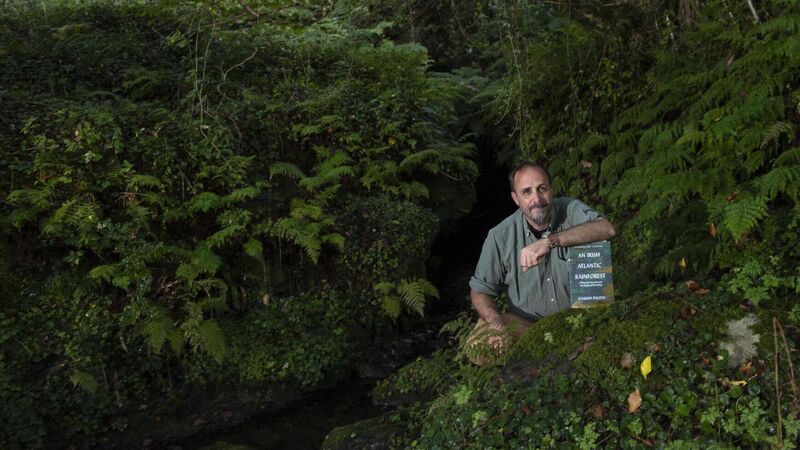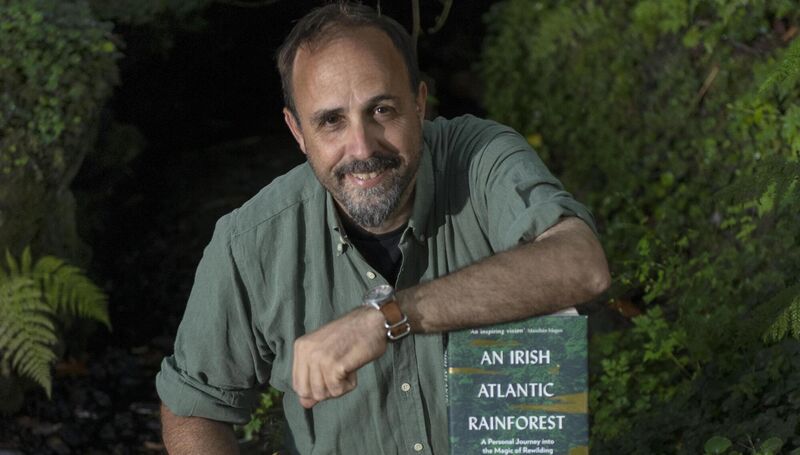The Beara rainforest: when healthy natural habitats are given a chance, 'the wild will return'

Eoghan Daltun with his book 'An Irish Atlantic Rainforest' at his home near Eyeries in West Cork. Picture: Don MacMonagle
Have you heard of the ‘Beara Rainforest’ on the Beara peninsula?
It is a native Irish Oak wood, soaking in moist Atlantic Air, to such an extent that it is classed as a temperate Irish rainforest. Overhead, ancient Oak trees form the canopy layer, mingling with Birch, Holly, Ash and other native trees. Big branches reach out in all directions, carpeted in luscious mosses and lichens. Ferns drape down from every available space.
The characteristic that defines a rainforest is that there is sufficient moisture in the air to sustain ‘epiphytes’ — plants that grow on other plants, without being rooted in the ground. When ferns line the mossy branch of an Oak tree, these are epiphytes. Temperate rainforests such as this once covered much of the west of Ireland, but now, because of human activity, only tiny pockets survive.
A native Rockforest (Co. Clare) pine, grown from seed by @dan_pathfinder, one of a bunch now happily growing away on my patch of the Beara Peninsula.
— Eoghan Daltun 🌍 (@IrishRainforest) September 26, 2022
Pollen records show that pine was a major component of the wildwood here in prehistory, so really it has come home. pic.twitter.com/XNPUOuSgN5
In 2019, Eoghan Daltun purchased the site containing the woods and moved there with his family. He began in earnest to restore the ecology of what was then a floundering ecosystem. The first task he took up was to remove substantial stands of invasive rhododendron which were shading out much of the woodland floor and preventing new sapling trees from establishing. He managed to get a grant to erect a tall fence, protecting the woodland from feral goats and Sika deer which had “reduced the ground flora to practically zero” and killed many of the trees by stripping the bark from the trunks. Restoration of this precious rainforest was underway. In just a decade, restorative actions have delivered what Eoghan describes as “spectacular results”.

In his new book, , Eagan tells the story of how he came to make the restoration of these woodlands these woodlands have sprung back to life, now home to an explosion of luxuriant growth and biodiversity in this west Cork rainforest. Without the competition of Rhododendron or the incessant nibbling of feral goats and deer, self-seeded saplings of wild Sessile Oak, Downy Birch, Holly, are growing strong and give hope for the future of not only these, but all our remaining native woodlands.
Within a few years, small native plants growing like tapestries on the woodland floor were stark contrast to what was once barren ground. As a result, an enormous diversity of wild bees, moths, hoverflies, butterflies and a plethora of other flying insects have been returning. The book vividly describes ‘a rainbow of iridescent metallic colours on a single purple flushed flower cluster of wild angelica’, referring to the insects there. Woodland birds are now thriving. Jays are particularly vociferous and colourful woodland birds which feed on acorns in autumn so they help spread potential new Oak trees far and wide. Red squirrels are happily settled in too. Rare ‘lesser horseshoe Bats’ have moved in to the area. Pine Martens and Otters returned, and Barn Owls were using the perimeter to hunt along.
In a natural woodland such as this, every organism is embroiled in a web of mutual support and interdependence. Eoghan has described the change as a ‘radical transformation on practically every level’. The restoration is demonstrating that when healthy natural habitats are given a chance, “the wild will return”.
An open glade in the woods, crammed with devil's-bit scabious.
— Eoghan Daltun 🌍 (@IrishRainforest) September 25, 2022
Spend some time here on a sunny day, and you get a glimpse of the true potential insect abundance and diversity of Ireland. pic.twitter.com/GRwebUzDD3
Woodlands such as this are the natural climax vegetation of much of Ireland, meaning that without clearances by human hand, this is what Ireland would still be covered in. The ‘rainforests’ are how nature expresses itself where the moisture levels are high, where Atlantic air masses are consistently moist. In this rewilding, the complex webs of life that thrived across much of Ireland's Atlantic seaboard until the 17th and 18th centuries are beginning to re-establish themselves. The name of the townlands where this woodland is gives clues to the history of the place. ‘Bofickil’ derives from Badh Fiadh-Choille, which translates as ‘recess of the wild wood’, and Faunkill, derives from Fan-Choill — ‘Sloping Wood’.
Now less than 2% of Ireland is covered in native woodland, the lowest cover in Europe. Those that remain are severely impacted by a combination of invasive species and overgrazing, such as described above. In an age of collapsing biodiversity, restoring and expanding those that remain has never been more urgent.
In this book, Eoghan also describes the fate of some other Atlantic Rainforests, including the Oak woodlands in Killarney National Park, (also temperate rainforests) and those at Uragh. Uragh, also in the Beara peninsula, is one of the few tiny parts of Ireland still covered in truly ancient woodland, defined as those existing pre-1660. In Ireland, we have less than 0.1% of such ancient woodlands. Maddeningly, none of these wondrous treasuries of life has been given the conservation actions they need to survive the ravages of overgrazing and invasive alien species. Even Uragh has been abandoned to slow decline. Due mainly to Eoghan’s highlighting of this shameful situation, efforts are now being made to protect Uragh and other Atlantic rainforests from dying on their feet.
This is a book that anyone with even a passing interest in nature or in Ireland’s history will enjoy and learn from. Not only is it an engaging personal story of one person’s journey of discovery, it is also a beautifully unfolding call to action, from a small plot of land in the southwest corner of Ireland, to the wider implications of biodiversity loss and restoration across the globe. Eoghan inspires brave and decisive action, and shows the power of ecological restoration from the personal to the planetary scale.
, by Eoghan Daltun, has just been published by Hachette Book Ireland






